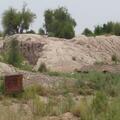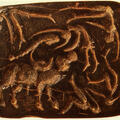There are two crocodilians found in the Indus river system: One is the mugger crocodile (Crocodylus palustris) also known as 'magar much', and the other is the gharial (Gavialis gangeticus).
344 posts, also carried on our Facebook page, about the ancient Indus Valley civilization, including important news, research and occasional visits to museums with ancient Indus artifacts.
Sep 11, 2016
If we may fantasize about where ancient Indus archaeology could go online, one need not look farther than the City of Ur project.
Sep 4, 2016
Sir Mortimer Wheeler, the excavator of the wall shown here, wrote that ". . . . both Harappa and Mohenjo-daro were dominated by am embattled acropolis or citadel, occupying a marginal block and built up with mud and mud-brick to a height of forty or fifty feet
Sep 3, 2016
Evidence for a tsunami hitting Dholavira at some point in the past was recently presented by scientists from the Indian National Institute of Oceanography (NIO).
Aug 28, 2016
Quite a bit. Release weekend August 12-14 visits to the site went from about 2 thousand to 8 thousand per day. With the latest stats, Facebook demographics and poll question.
Aug 28, 2016
"The earliest representation of a unicorn is found on seals and sealings from sites in the northern Indus region, dated to c. 2600 BCE," writes Jonathan Mark Kenoyer.
Aug 26, 2016
The film Mohenjo Daro opens in the remote village of Amri, where Sarman (Hrithik Roshan) and his friends wrestle a large crocodile in a riverine gorge.
Aug 21, 2016
The seal that the publicity emblem (above) for the film Mohenjo Daro is actually based on (below) offers the opportunity to look at one of the most unresolved issues in ancient Indus studies: what was the so-called one-horned unicorn, and where did it come
Aug 20, 2016
A wide-ranging interview with one of our ancient Indus scholars, author and archaeologist Shereen Ratnagar.
Aug 20, 2016
"On another seal, No. 510 [in Mackay], a buffalo appears to have attacked a number of people who are lying on the ground around him in every conceivable attitude," writes the excavator Ernest Mackay.
Aug 15, 2016
Will the movie Mohenjo Daro open the floodgates of popular interest in the ancient Indus civilization? What do you think?
Twenty-one years into running Harappa.com, the release of Mohenjo Daro is a landmark for interest in the subject (traffic in the last few days has doubled to five thousand people a day).
Aug 13, 2016
1. A clay sealing from the Harappa Phase levels (2600-1900 BCE) that may have come from a large bundle of goods shipped to the site from a distant region.
Aug 12, 2016
Mohenjo-daro has been called the "city of wells." Mark Kenoyer writes: "On the basis of the number of wells found in the excavated areas, Michael Jansen has calculated that the city may have had over 700 wells.
Aug 6, 2016
An interesting story in light of all the speculation about water issues at the same time, roughly 1900 BCE, in the ancient Indus valley. There was possibly a trading relationship with ancient China. Water, too little or too much, must have been a factor in the rise and fall of Bronze Age civilizations.
Aug 6, 2016
A revealing story about Rakigarhi highlights how, like in the case of Mohenjo-daro, the challenges of preserving ancient Indus cities even after they are discovered, remain enormous.














